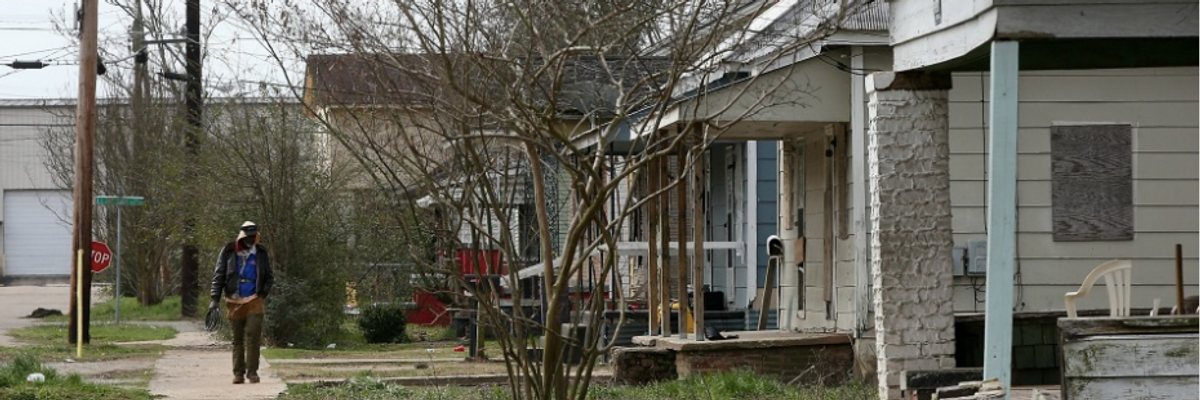At the end of 2017, the United Nations Special Rapporteur on Extreme Poverty and Human Rights, Professor Philip Alston, published a statement on his official visit to the United States. The statement makes for sobering reading even for those whose work focuses on domestic poverty. It should not be too surprising that the U.N. would investigate extreme poverty in the United States. Luke Schaffer and Kathryn Edin's "$2.00 a Day: Living on Almost Nothing In America" (2015) did a phenomenal job presenting a history of the policies--most notably welfare reform, signed into law by President Clinton in 1996--that gutted the social safety net.
Schaffer and Edin found that "1.65 million households with about 3.55 million children were surviving on $2 or less in cash income per person per day in a given month" in 2011. Earlier reporting by Jason DeParle and Robert Gebeloff showed that across the country food stamps are the only income of many poor families. As part of a long list of poverty facts, the Special Rapporteur's statement highlighted that the United States has the highest infant mortality rate in the developed world and that "the youth poverty rate in the United States is the highest across the OECD with one quarter of youth living in poverty compared to less than 14% across the OECD." As Alston noted, despite claims of American exceptionalism, "contrasts between private wealth and public squalor abound."
The visible levels of poverty and of inequality in the United States are not unique to this country. The presence of "help"--servants receiving poverty wages--in the wealthy and middle class houses is ubiquitous across much of Latin America.
Every major city in Europe struggles with homelessness and unemployed people can be found huddling for hours over a single coffee in the McDonald's in Kyoto, Japan in much the same way as their counterparts do below golden arches across Washington, D.C. But sometimes it takes an international perspective to bring America's limited responses to poverty into relief. The conservative take on anti-poverty programs is simple even if it often stretches all bounds of credibility.
Championed by organizations such as the Heritage Foundation, conservatives argue that not only are the U.S. poor not actually poor (after all, they have TVs, refrigerators, and air-conditioning, not to mention cell phones) but the government wastes a tremendous amount of money, upwards of "$1 trillion each year on welfare," trying to help the poor. For those holding a blame-the-poor worldview (and all too frequently a self-congratulatory celebrate-the-rich mentality), truth is no obstacle. No wonder that Republican governors have pushed for universal drug testing of welfare and food stamp recipients despite a complete absence of proof that such expensive testing programs are addressing a real problem. The same goes for conservative efforts to target EITC recipients with tax audits but diminish the ability of the IRS to audit wealthier filers. The conservative end goal is clear--kill the welfare state--and, implicitly, punish the poor.
But if the state is supposed to give massive tax breaks to the rich and dedicate most public spending to the military--Alston's statement observes that the United States "spends more on national defense than China, Saudi Arabia, Russia, United Kingdom, India, France, and Japan combined"--what entities are going to help the poor? Alston's official statement applauded the St. Boniface Catholic Church in San Francisco, which "opens its pews to the homeless every day between services," but as an article by Ed Pilkington, a reporter who accompanied Alston on his official tour, noted, "apart from St Boniface and its sister church, no other place of worship in San Francisco welcomes homeless people.
In fact, many have begun, even at this season of goodwill, to lock their doors to all comers simply so as to exclude homeless people." Though the conservative line is that poverty is best attacked at the local level with local solutions, even the architect of welfare reform, Ron Haskins, has acknowledged that the experience giving states flexibility under TANF "has got to give you pause" when considering block grant proposals. An in-depth investigation by the Guardian suggests cities are no better than states. Their solution to homelessness: one-way bus tickets elsewhere with little regard for what happens at the end of the line.
The international perspective on U.S. poverty offered by the U.N. Special Rapporteur on Extreme Poverty and Human Rights offers a number of important lessons. First, that there are people living with extreme poverty in the United States, it is not a phenomenon limited to developing countries. Second, that the United States has the resources to help the poor, including children living in poverty, far more than we do. And third, that America's relative tolerance for high levels of poverty and inequality and exceptional indifference to the hardships endured by the poor therefore reflect political and institutional choices.
Among antipoverty advocates, it is tempting to try to define the enemy as Donald Trump, Paul Ryan, and others in the current administration, but the coming frontal attack on welfare is only possible because so many Americans likewise demonize the poor. As the Special Rapporteur's statement ominously warns, these efforts, if successful, "will essentially shred crucial dimensions of a safety net that is already full of holes."

